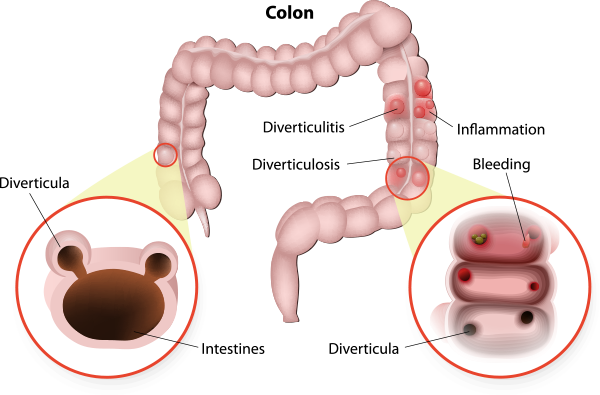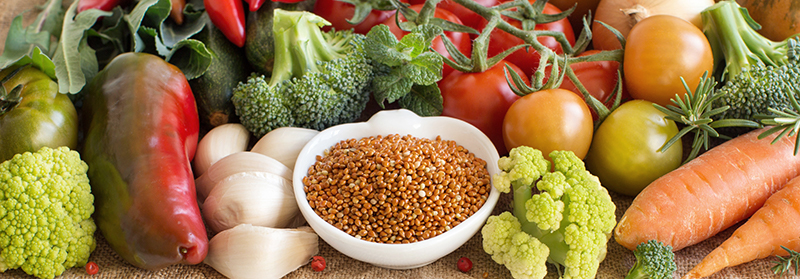Diverticulitis
More Common as We Age
More Common as We Age
Many people have small pouches in their colons that bulge outward through weak spots, like an inner tube that pokes through weak places in a tire. Each pouch is called a diverticulum. The condition of having several diverticulum is called diverticulosis. About 10 percent of Americans over the age of 40 have diverticulosis. The condition becomes more common as people age – nearly half of all people over the age of 60 have diverticulosis.
When the pouches become infected or inflamed, the condition is called diverticulitis. This occurs in 10 percent to 25 percent of people with diverticulosis. Diverticulosis and diverticulitis are also called diverticular disease.

What is the difference between diverticulosis and diverticulitis?
Diverticulosis is the result of weak areas within the colon wall and high pressure within the colon leading to small pockets that develop along the wall of the colon, most commonly the sigmoid colon. The presence of these pockets are usually not a problem and it is common to see these pockets on colonoscopy as people age.
Diverticulitis is when these pockets become infected and inflamed.
Can I eat seeds and nuts if I have diverticulosis/diverticulitis?
In the past, there were recommendations to avoid seeds and nuts for diverticular disease, but studies have shown that it has no bearing on diverticular disease and attacks.
What kind of diet should I follow for diverticular disease?
A high fiber diet is recommended for diverticular disease. Approximately 25-30 grams of fiber per day should be the goal.
Although not proven, the dominant theory is that a low-fiber diet is the main cause of diverticular disease. The disease was first noticed in the United States in the early 1900s. At about the same time, processed foods were introduced into the American diet. Many processed foods contain refined, low-fiber flour. Unlike whole-wheat flour, refined flour has no wheat bran.
Diverticular disease is common in developed or industrialized countries — particularly the United States, England and Australia — where low-fiber diets are common. The disease is rare in Asia and Africa, where people eat high-fiber vegetable diets.
Fiber is the part of fruits, vegetables and grains that the body cannot digest. Some fiber dissolves easily in water (soluble fiber). It takes on a soft, jelly-like texture in the intestines. Some fiber passes almost unchanged through the intestines (insoluble fiber). Both kinds of fiber help make stools soft and easy to pass. Fiber also prevents constipation.
Constipation makes the muscles strain to move stool that is too hard. It is the main cause of increased pressure in the colon. This excess pressure might cause the weak spots in the colon to bulge out and become diverticula.
Diverticulitis occurs when diverticula become infected or inflamed. Doctors are not certain what causes the infection. It may begin when stool or bacteria are caught in the diverticula. An attack of diverticulitis can develop suddenly and without warning.

To diagnose diverticular disease, we’ll ask about your medical history, give you a physical exam, and we may perform one or more diagnostic tests. Because most people don’t have symptoms, diverticulosis is often found through tests ordered for another ailment.
When taking a medical history, we will ask about bowel habits, symptoms, pain, diet and medications. The physical exam usually involves a digital rectal exam. We may check your stool for signs of bleeding and test blood for signs of infection. We may also order X-rays or other tests.
Diverticulitis: Treatment for diverticulitis focuses on clearing up the infection and inflammation, resting the colon, and preventing or minimizing complications. An attack of diverticulitis without complications may respond to antibiotics within a few days if treated early. To help the colon rest, we may recommend bed rest and a liquid diet, along with a pain reliever.
An acute attack with severe pain or severe infection may require a hospital stay. Most acute cases of diverticulitis are treated with antibiotics and a liquid diet. The antibiotics are given by injection into a vein. In some cases, however, surgery may be necessary.
Diverticulosis: For most people with diverticulosis, eating a high-fiber diet is the only treatment required. Fiber keeps stool soft and lowers pressure inside the colon so that bowel contents can move through easily. The American Dietetic Association recommends 20 to 35 grams of fiber each day. The table at right shows the amount of fiber in some foods that you can easily add to your diet.
If attacks are severe or frequent, we may advise surgery. The surgeon removes the affected part of the colon and joins the remaining sections. This type of surgery, called colon resection, aims to keep attacks from coming back and to prevent complications. We may also recommend surgery for complications of a fistula or intestinal obstruction. Many times this surgery can be performed laproscopically which usually allows for smaller incisions and faster healing.